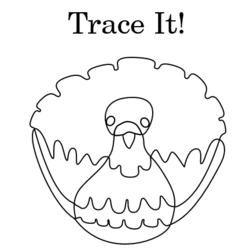For Turkey Day
 Can you trace out the lines of the
entire
turkey?
Can you trace out the lines of the
entire
turkey?
Things to keep in mind while tracing:
No picking up your writing or tracing tool.
No doubling back along a line already traced.
Hint: Careful with the beak!
This section requires Javascript.
You are seeing this because something didn't load right. We suggest you, (a) try
refreshing the page, (b) enabling javascript if it is disabled on your browser and,
finally, (c)
loading the
non-javascript version of this page
. We're sorry about the hassle.
This particular turkey is a special case for this kind of tracing problem.
As you can see in the coloring below, this turkey is made out of 1 beak + 6 overlapping, squiggly loops. Additionally, one loop is special: the green loop intersects every other loop at least once. As a result, here's our strategy:
Since any loop can be traced all at once, ending wherever you began, start at the left side of the beak and move (on purple) to green, then trace along green and, any time you reach a new color, trace that entire colored loop, coming back to the green loop where you left it. Lastly, when you get back to purple, finish purple returning to the diamond where you started and then trace the beak last.
There are many other ways to trace this Turkey of course, but this kind of method will serve you well for any picture that is made almost entirely out of a collection of overlapping loops. Actually, I'm pretty bad at tracing so I basically can't do this puzzle by actually trying to trace it -- too many squiggles. In this case, the mathematical approach is easier in my opinion. ;-)
Happy Thanksgiving!
An example path: